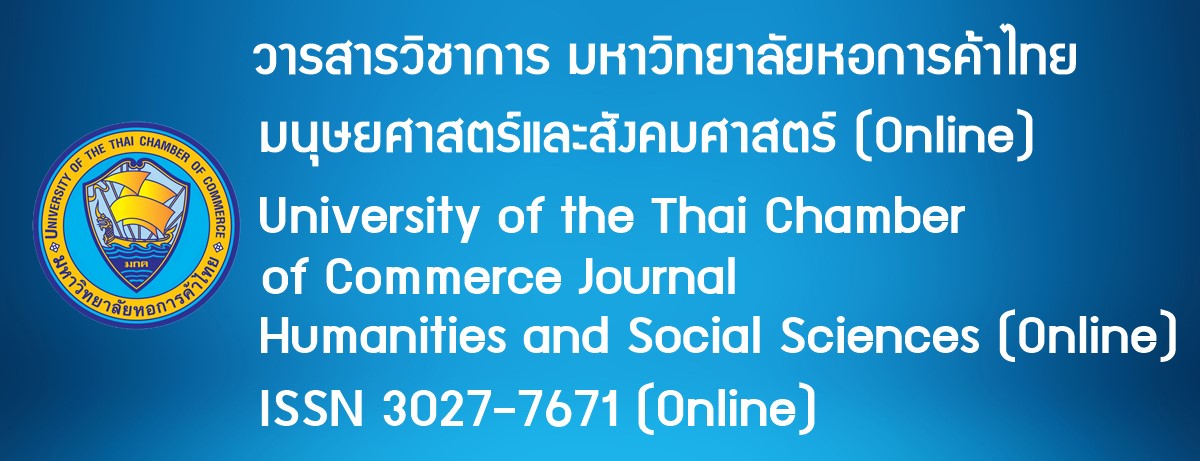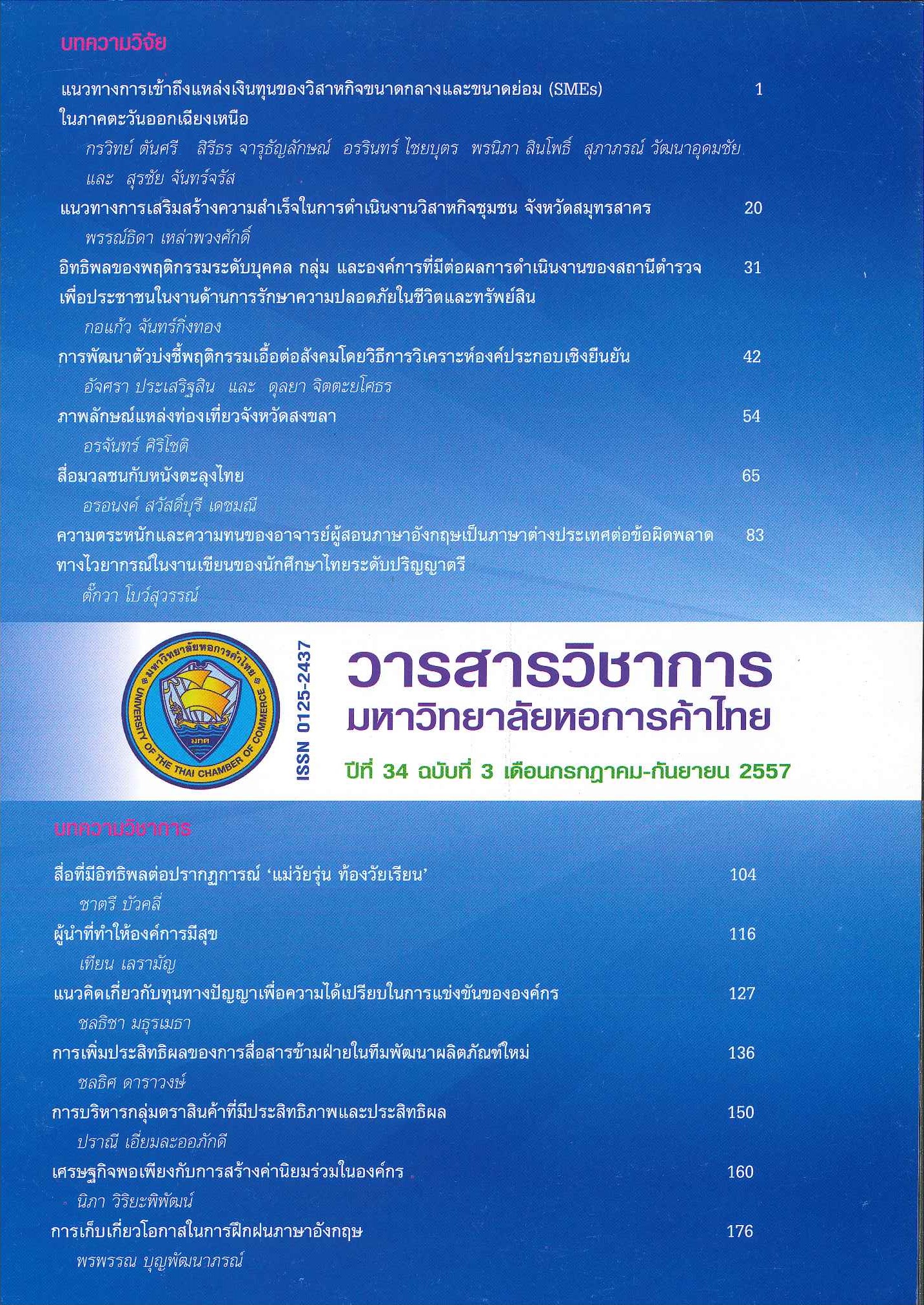ความตระหนักและความทนของอาจารย์ผู้สอนภาษาอังกฤษเป็นภาษาต่างประเทศต่อข้อผิดพลาดทางไวยากรณ์ ในงานเขียนของนักศึกษาไทยระดับปริญญาตรี
Main Article Content
บทคัดย่อ
การวิจัยนี้มีวัตถุประสงค์เพื่่อสำรวจความตระหนักและความทนของอาจารย์ผู้สอนภาษาอังกฤษเป็นภาษาต่างประเทศต่อข้อผิดพลาดทางไวยากรณ์ ในงานเขียนของนักศึกษาไทยระดับปริญญาตรี โดยใช้แบบสอบถามจำนวน 20 หน้า สำหรับข้อผิดพลาดทางไวยากรณ์ 19 ชนิด จากประสบการณ์การสอนของผู้ทำวิจัยเองและจากผลงานวิจัยต่างๆ ผลการวิจัย (ไม่รวม Miscellaneous Errors) มีดังนี้คือ พบความถี่ของข้อผิดพลาด 16 ชนิด อยู่ในระดับกลาง (41-60%) 2 ชนิด พบบ่อย (61-80%) ได้แก่ Article และ Verb Tense ข้อผิดพลาดที่พบมาก 5 อันดับแรกได้แก่ Article, Verb Tense, Run-on Sentence, Fragment และ Subject-verb Agreement ตามลำดับ ข้อผิดพลาดที่อาจารย์คิดว่ามีอิทธิพลมาจากภาษาแม่เกือบ 50% หรือมากกว่า ได้แก่ Word Order, Fragment, Run-on Sentence, Over-marking of Conjunction และ Singular or Plural Form ส่วนข้อผิดพลาดในกลุ่ม Intralingual พบว่ามีสาเหตุมาจาก Incomplete Application of Rules and Ignorance of Rule Restrictions มากกว่าสาเหตุอื่นๆ ส่วนในเรื่องความทนต่อข้อผิดพลาดพบว่าอาจารย์แก้ไขข้อผิดพลาด 17 ชนิดทันทีหรือเร็วที่สุดเท่าที่ทำได้ มีเพียง 1 ชนิด ได้แก่ Preposition ที่แก้ไขเมื่อจบบทเรียน นอกจากนั้นยังพบว่าไม่มีความสัมพันธ์ระหว่างความถี่ของข้อผิดพลาดที่พบกับความทนต่อข้อผิดพลาด ยกเว้นกับ Article (Insertion) และ Subject-object Pronoun และพบว่าไม่มีความสัมพันธ์ระหว่างชนิดของข้อผิดพลาด (Global/Local) กับความทน ยกเว้นกับ Verb Tense (Sequence) และ Modal Verb
Article Details
ลิขสิทธิ์ของบทความ
ผลงานที่ได้รับการตีพิมพ์ถือเป็นลิขสิทธิ์ของมหาวิทยาลัยหอการค้าไทย ห้ามมิให้นำเนื้อหา ทัศนะ หรือข้อคิดเห็นใด ๆ ของผลงานไปทำซ้ำ ดัดแปลง หรือเผยแพร่ ไม่ว่าทั้งหมดหรือบางส่วนโดยไม่ได้รับอนุญาตเป็นลายลักษณ์อักษรจากมหาวิทยาลัยหอการค้าไทยก่อน
References
Bataineh, R. F. 2005. “Jordanian Undergraduate EFL Students’ Errors in the Use of the Indefinite Article.” Asian EFL Journal Quarterly 7, 1: 56-76.
Bitchener, J., Young, S., and Cameron, D. 2005. “The Effect of Different Types of Corrective Feedback on ESL Student Writing.” Journal of Second Language Writing 14: 191-205.
Boonpattanaporn, P. 2008. “Comparative Study of English Essay Writing Strategies and Difficulties as Perceived by English Major Students: A Case Study of Students in the School of Humanities, University of the Thai Chamber of Commerce.” University of the Thai Chamber of Commerce Journal 28, 2: 75-90.
Brown, H.D. 1987. Principles of Language Learning and Teaching. 2nd ed. Englewood Cliffs, NJ: Prentice Hall.
Burt, M. K., and Kiparsky, C. 1972. The Gooficon: A Repair Manual for English. Rowley, MA: Newbury House.
Chan, A. Y. W. 2004. “Syntactic Transfer: Evidence from the Interlanguage of Hong Kong Chinese ESL Learners.” The Modern Language Journal 88, 1: 56-74.
Chandler, J. 2003. “The Efficacy of Various Kinds of Error Feedback for Improvement in the Accuracy and Fluency of L2 Student Writing.” Journal of Second Language Writing 12: 267-296.
Chatranonth, P. 2008. “Impact of Teacher Feedback on Students' Grammatical Writing Accuracy: A Case Study in Thailand.” Doctoral dissertation, University of Manchester.
Corder, S. P. 1967. “The Significance of Learners’ Errors.” International Review of Applied Linguistics in Language Teaching 5, 4: 161-170.
Corder, S. P. 1971. “Idiosyncratic Dialects and Error Analysis.” International Journal of Applied Linguistics 9: 149-159.
Corder, S. P. 1974. “Error Analysis.” In J.P.B. Allen and S. Pit Corder (eds.), Techniques in Applied Linguistics, pp.122-154. London: Oxford University Press.
Corder, S. P. 1981. Error Analysis and Interlanguage. Oxford: Oxford University Press.
Doughty, C.J., and Long, M.H. 2003. The Handbook of Second Language Acquisition. Oxford: Oxford University Press.
Duskova, L. 1969. “On Sources of Errors in Foreign Language Learning.” International Review of Applied Linguistics 7: 11-36.
Erel, S., and Bulut, D. 2007. “Error Treatment in L2 Writing: A Comparative Study of Direct and Indirect Coded Feedback in Turkish EFL Context.” Journal of Institute of Social Sciences, Erciyes University 23,1: 397-415.
Ellis, R. 1997. Second Language Acquisition. Oxford: Oxford University Press.
Hendrickson, J. 1983. Error Analysis and Error Correction in Language Teaching. Singapore: Seameo Regional Language Centre.
Hyland, K., and Anan, E. 2006. “Teachers’ Perceptions of Error: The Effects of First Language and Experience.” System 34: 509-519.
James, C. 1998. Errors in Language Learning and Use: Exploring Error Analysis. London: Longman.
James, C. 2001. Errors in Language Learning and Use: Exploring Error Analysis. Beijing: Foreign Language Teaching and Research Press.
Klassen, J. 1991. “Using Student Errors for Teaching.” Forum 29, 1: 10-12.
Krachen, S. D., and Seliger, H. W. 1975. “The Essentials Contributions of Formal Instruction in Adult Second Language Learning.” TESOL Quarterly 9, 2: 173-183.
Kulsirisawad, P. 2012. “Developing Learner Autonomy in EFL Writing Classrooms via Peer Feedback.” In CULI National Seminar 2012 Electronic Proceeding, 19-20 November 2012 at Chulalongkorn University Language Institute, pp. 1-10 [Online]. Available: https://www.culi.chula.ac.th/international/conferences/National/national2012/Proceeding/Dr%20Phnita.pdf
Larsen-Freeman, D., and Long, M. 1991. An Introduction to Second Language Acquisition Research. New York: Longman.
Lu, T. 2010. “Correcting the Errors in the Writing of University Students in the Comfortable Atmosphere.” International Education Studies 3, 3: 74-78.
Norrish, J. 1983. Language Learners and their Errors. London. Macmillan.
Richards, J. C. 1971. “A Non-Contrastive Approach to Error Analysis.” English Language Teaching Journal 25: 204-219.
Richards, J. C., and Simpson, G. P. 1974. “The Study of Learner English.” In J. C. Richards (ed.), Error Analysis: Perspectives on Second Language Acquisition, pp. 3-18. London: Longman.
Schachter, J. 1974. “An Error in Error Analysis.” Language Learning 24: 205-214.
Selinker, L. 1972. “Interlanguage.” International Journal of Applied Linguistics 10: 209-231.
Sheen, Y. 2007. “The Effect of Focused Corrective Feedback on Error and Language Aptitude on ESL Learners’ Acquisition of Articles.” TESOL Quarterly 41, 2: 255-283.
Sheorey, R. 1986. “Error Perceptions of Native-Speaking and Non-Native-Speaking Teachers of ESL.” ELT Journal 40, 4: 306-312.
Srichanyachon, N. 2011. “A Comparative Study of Three Revision Methods in EFL Writing.” Journal of College Teaching and Learning 8, 9: 1-8.
Tangpermpoon, T. 2008. “Integrated Approaches to Improve Students’ Writing Skills for English Major Students.” ABAC Journal 28, 2: 1-9.
Truscott, J. 1996. “The Case against Grammar Correction in L2 Writing Classes.” Language Learning 46, 2: 327-369.
Truscott, J., and Yi-ping Hsu, A. 2008. “Error Correction, Revision, and Learning.” Journal of Second Language Writing 17: 292-305.
Ubol, C. 1981. An Error Analysis of English Compositions by Thai Students. Singapore: Seameo Regional Language Centre.
Wongsothorn, A. 1983. “Analysis of Language Transfers from Thai to English in Three Types of Discourse: Explanatory, Descriptive and Persuasive.” PASAA: Journal of Language Teaching and Learning in Thailand Special issue: 83-87.

